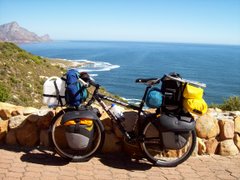




The Holy Ganga (Ganges) River emerges from the foothills of the Himalaya at a place called Rishikesh (also known for a visit by “The Beetles” in their hey-day). Due to its location Rishikesh is a Hindu holy city, with crowds of pilgrims crossing the suspension bridges to the temples each day. It is also the self-proclaimed world centre for yoga and such-like things. We’ve been here in Rishikesh for about a week now, because Leana became rather ill the day after we arrived. We suspected Dengue Fever, but there was no medical doctor close by so Leana consulted a herbalist/yoga sort of practitioner who said she’d been poisoned by mal-digestion (and he prescribed lots of unpalatable herbs from his shop). During the consultation I found a lot of what “the doctor” said interesting and sometimes it even sounded plausible, but he lost me when he said that “cycling wasn’t exercise, but something else which just drained the body and wore it down”. Anyway, there is no treatment for Dengue Fever, so hopefully Leana recovers within the next week (which is about the same period which the prescribed herbs would take to show effect). There are some wonderful temples and shrines here, as there are in the other places which we’ve visited so far in India. We haven’t traveled very far since leaving Chandigarh due to more bike trouble, and we also had to shelter from the late Monsoon rain in Dehradun for a few days (where we visited the giant World Peace Buddhist Stupa and statue). This region of Northern India is green and forested, with some hilly areas. However, India is quite a crowded place, and there is almost constant villages and chaotic traffic through which we’ve cycled. The last 20 km to the hilltop town of Nahan was up a narrow, steep, winding road with a poor surface, and we only arrived there about 2 hours after dark. Not only do these towns have holy cows wandering the streets, there are also troops of monkeys causing havoc (pulling washing off the line – and stealing food wherever a window or door is left open). One of my t-shirts (with a hole bitten in it) had to be retrieved from a tree, and I was almost robbed of a bunch of bananas while returning to our room with the purchase.
Daily distances cycled since Chandigarh were:- Nahan 103 km; Dehradun 98 km; Rishikesh 49 km; and Midway (loop) 35 k. Total distance since Cape Town – 27171 km.


















